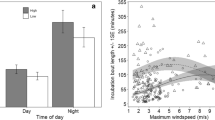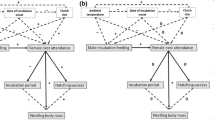Abstract
Incubating birds balance their energetic demands during incubation with the needs of the developing embryos. Incubation behavior is correlated with body size; larger birds can accumulate more endogenous reserves and maintain higher incubation constancy. King eiders (Somateria spectabilis) contend with variable and cold spring weather, little nesting cover, and low food availability, and thus are likely to rely heavily on endogenous reserves to maintain high incubation constancy. We examined the patterns of nest attendance of king eiders at Teshekpuk and Kuparuk, Alaska (2002–2005) in relation to clutch size, daily temperature, and endogenous reserves to explore factors controlling incubation behavior. Females at Kuparuk had higher constancy (98.5 ± 0.2%, n = 30) than at Teshekpuk (96.9 ± 0.8%, n = 26), largely due to length of recesses. Mean recess length ranged from 21.5 to 23.7 min at Kuparuk, and from 28.5 to 51.2 min at Teshekpuk. Mean body mass on arrival at breeding grounds (range; Teshekpuk 1,541–1,805, Kuparuk 1,616–1,760), and at the end of incubation (Teshekpuk 1,113–1,174, Kuparuk 1,173–1,183), did not vary between sites or among years (F < 1.1, P > 0.3). Daily constancy increased 1% with every 5°C increase in minimum daily temperature (β min = 0.005, 95% CI 0.002, 0.009). Higher constancy combined with similar mass loss at Kuparuk implies that females there met foraging requirements with shorter recesses. Additionally, females took more recesses at low temperatures, suggesting increased maintenance needs which were potentially ameliorated by feeding during these recesses, indicating that metabolic costs and local foraging conditions drove incubation behavior.



Similar content being viewed by others
References
Afton AD (1980) Factors affecting incubation rhythms of Northern Shovelers. Condor 82:132–137
Afton AD, Paulus SL (1992) Incubation and brood care. In: Batt BD, Afton AD, Anderson MG, Ankney CD, Johnson DH, Kadlec JA, Krapu GL (eds) Ecology and management of breeding waterfowl. University Minnesota Press, Minneapolis, pp 62–108
Aldrich TW, Raveling DG (1983) Effects of experience and body weight of incubation behavior of Canada geese. Auk 100:670–679
Ankney CD, MacInnes CD (1978) Nutrient reserves and reproductive performance of female lesser snow geese. Auk 95:459–471
Bentzen RL, Powell AN, Williams TD, Kitaysky AS (2008a) Characterizing the nutritional strategy of incubating king eiders Somateria spectabilis in northern Alaska. J Avian Biol 39:683–690. doi:10.1111/j.1600-048X.2008.04442.x
Bentzen RL, Powell AN, Suydam RS (2008b) Factors influencing nesting success of king eiders on northern Alaska’s coastal plain. J Wildl Manage 72:1781–1789. doi:10.2193/2007-345
Bentzen RL, Powell AN, Suydam RS (2009) Strategies for nest-site selection by king eiders. J Wildl Manage 73:932–938. doi:10.2193/2008-411
Bolduc F, Guillemette M (2003) Incubation constancy and mass loss in the common eider Somateria mollissima. Ibis 145:329–332. doi:10.1046/j.1474-919X.2003.00143.x
Burgess RM (2000) Arctic fox. In: Truett JC, Johnson SR (eds) The natural history of an arctic oil field: development and the biota. Academic Press, San Diego, pp 159–178
Burnham KP, Anderson DR (2002) Model selection and multimodel inference: a practical information-theoretic approach, 2nd edn. Springer-Verlag, New York
Criscuolo F, Gabrielsen GW, Gendner J-P, Le Maho Y (2002) Body mass regulation during incubation in female common eiders Somateria mollissima. J Avian Biol 33:83–88. doi:10.1034/j.1600-048X.2002.330113.x
Eberhardt LE, Hanson WC, Bengtson JL, Garrott RA, Hanson EE (1982) Arctic fox home range characteristics in an oil-development area. J Wildl Manage 46:183–190
Fast PLF, Gilchrist HG, Clark RG (2007) Experimental evaluation of nest shelter effects on weight loss in incubating common eiders Somateria mollissima. J Avian Biol 38:205–213. doi:10.1111/j.0908-8857.2007.03820.x
Flint PL (2003) Incubation behaviour of greater scaup Aythya marila on the Yukon-Kuskokwim delta, Alaska. Wildfowl 54:71–79
Flint PL, Grand JB (1999) Incubation behavior of spectacled eiders on the Yukon-Kuskokwim delta, Alaska. Condor 101:413–416
Gatti RC (1983) Incubation weight loss in the mallard. Can J Zool 61:565–569
Girard GL (1939) Notes on the life history of the shoveler. Tran N Am Wildl Conf 4:364–371
Gloutney ML, Alisauskas RT, Afton AD, Slattery SM (2001) Foraging time and dietary intake by breeding Ross’s and lesser snow geese. Oecologia 127:78–86. doi:10.1007/s004420000577
Hanssen SA, Hasselquist D, Folstad I, Erikstad KE (2005) Cost of reproduction in a long-lived bird: incubation effort reduces immune function and future reproduction. Proc R Soc Lond B 272:1039–1049. doi:10.1098/rspb.2005.3057
Harvey WF, Hepp GR, Kennamer RA (1989) Body mass dynamics of wood ducks during incubation: individual variation. Can J Zool 67:570–574
Kellett DK (1999) Causes and consequences of variation in nest success of king eiders (Somateria spectabilis) at Karrak Lake, Northwest Territories. Thesis, University of Saskatchewan
Kellett DK, Alisauskas RT (2000) Body-mass dynamics of king eiders during incubation. Auk 117:812–817. doi:10.1642/0004-8038(2000)117[0812:BMDOKE]2.0.CO;2
Korschgen CE (1977) Breeding stress of female eiders in Maine. J Wildl Manage 41:360–373
Kovach Computing Services (2005) Oriana Version 1. Kovach Computing Services, Anglesey
Lamothe P (1973) Biology of the king eider (Somateria spectabilis) in a freshwater breeding area on Bathurst Island, N.W.T. Thesis, University of Alberta
MacCluskie M, Sedinger J (1999) Incubation behavior of Northern Shovelers in the subarctic: a contrast to the prairies. Condor 101:417–421
Mallory ML, Weatherhead PJ (1993) Incubation rhythms and mass loss of common goldeneyes. Condor 95:849–859
National Climatic Data Center (2007) Climate-radar data inventories. http://www.ncdc.noaa.gov/oa/ncdc. Accessed 13 Feb 2007
Oppel S (2008) King eider migration and seasonal interactions at the individual level. Dissertation, University of Alaska Fairbanks
Oppel S, Powell AN, Dickson DL (2008) Timing and distance of king eider migration and winter movements. Condor 110:296–305
Parker H, Holm H (1990) Patterns of nutrient and energy expenditure in female common eider nesting in the high arctic. Auk 107:660–665
Quakenbush L, Suydam R, Obritschkewitsch T, Deering M (2004) Breeding biology of steller’s eiders (Polysticta stelleri) near barrow, Alaska, 1991–99. Arctic 57:166–182
SAS Institute (1990) SAS/STAT user’s guide, version 6, 4th edn. SAS Institute, Cary
Swennen C, Ursem JCH, Duiven P (1993) Determinate laying and egg attendance in common eiders. Ornithol Scand 24:48–52
Thompson SC, Raveling DG (1987) Incubation behavior of emperor geese compared with other geese: interactions with predation, body size, and energetics. Auk 104:707–716
Truett JC, Miller ME, Kertell K (1997) Effects of arctic Alaska oil development on brant and snow geese. Arctic 50:138–146
Weller MW (1956) A simple field candler for waterfowl eggs. J Wildl Manage 20:111–113
Zar JH (1999) Biostatistical analysis, 4th edn. Prentice Hall, New Jersey
Zicus MC, Hennes SK, Riggs MR (1995) Common goldeneye nest attendance patterns. Condor 97:461–472
Acknowledgments
This study would not be possible without the financial and logistical support of the Minerals Management Service, Coastal Marine Institute, Bureau of Land Management, ConocoPhillips Alaska Inc., USGS Alaska Cooperative Fish and Wildlife Research Unit, and Sandpiper Technologies Inc. Funding from the North Slope Borough was through the National Petroleum Reserve-Alaska Impact Mitigation Program. North Slope Borough Search and Rescue provided some helicopter support. This study was endorsed by the Sea Duck Joint Venture. We thank the administrative staff at the North Slope Borough Department of Wildlife Management, ConocoPhillips Inc. Environmental Studies, and all the many field technicians. We thank Lincoln Parrett for access to weather data from the weather station at the Teshekpuk site. Comments by Paul Flint, Alexander Kitaysky, Dana Thomas, Dana Kellett, Sveinn Hanssen, and an anonymous reviewer were greatly appreciated and improved previous versions of the manuscript. Any use of trade, product, or firm names in this publication is for descriptive purposes only and does not imply endorsement by the US government.
Author information
Authors and Affiliations
Corresponding author
Rights and permissions
About this article
Cite this article
Bentzen, R.L., Powell, A.N., Phillips, L.M. et al. Incubation behavior of king eiders on the coastal plain of northern Alaska. Polar Biol 33, 1075–1082 (2010). https://doi.org/10.1007/s00300-010-0787-y
Received:
Revised:
Accepted:
Published:
Issue Date:
DOI: https://doi.org/10.1007/s00300-010-0787-y




